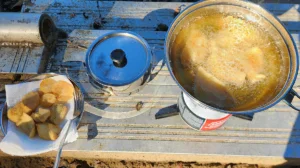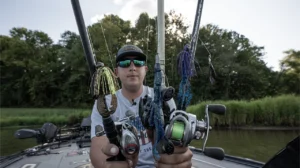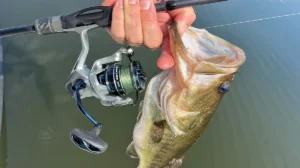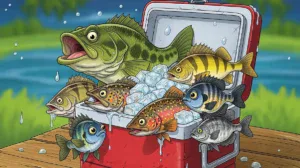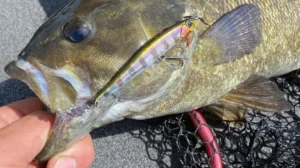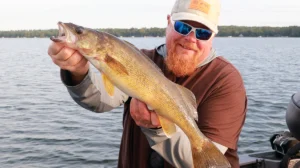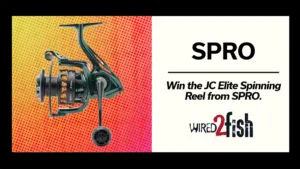When anglers think about fishing during the summer months, one word comes to mind: tough!
Being cool-water fish, smallmouth bass tolerate the warm waters of the summer, but don’t exactly thrive. It’s just that time of year that makes you pull your hair out of your head. They are there in many of the spots you probably know but getting them to bite is like pulling teeth.
So what should you do when the water is 80 degrees and the smallmouth aren’t cooperating? Is there a certain technique that works better than others? Is there a magical depth that they love to hide out in? Summertime smallies can be some of my all time favorite fish to catch. They can be stingy and uncooperative just like your ex-girlfriend. But when you figure them out, they will usually treat you right. Here are some of the best smallmouth tactics that are proven to work throughout the heat of the summer.
Probing The Shallows

You probably think that all the smallmouth escape the shallows in the summer, but that couldn’t be farther from the truth. A lot of forage still lingers throughout the shallows, like bluegills, gobies, crayfish and perch. Even though the water warms, smallmouth have no reason to leave. In lakes that have both popular species of bass, they will often coexist with each other.
But, that does come with a price. Smallmouth that live in these skinny waters are often extremely spooky. And for good reason – they can see, hear and feel just about everything!
Hardcore kayak angler and host of the Serious Angler Podcast, Bailey Eigbrett, knows a thing or two about chasing spooky smallmouth up shallow. With a kayak, you can come into an area more subtly than with a bass boat. Eigbrett prefers to throw both a spybait, like a Duo Realis Spinbait 80, or a hair jig.
“If there’s a smallmouth shallower than 15 feet, they’ll eat the hair or the spybait,” Eigbrett says. “It’s a great summer bait as it’s subtle and effective.”
There’s something to be said about extremely subtle baits in skinny water. If you look at their action, you will see that they have almost none, but the action that’s there entices curious smallmouths.
For hair jigs, there’s so many on the market to choose from, but only some roll through the water and look natural. I usually get my jigs custom tied by local friends, such as Tristen Bauer from T’s Tackle NY in Theresa, New York. But if you’re looking for quality jigs in the tackle shop, check out the Beast Coast Fishing Superfly and Great Lakes Finesse Marabou Jig. Both are made from great hair and components, as well as move effortlessly through the water.
The key for both baits is to make an extremely long cast. I fish these baits on a seven-foot, six-inch (medium-light-action) rod paired with five-pound-test Cortland Master Braid to eight-pound fluorocarbon leader. The long cast ensures these fish will not get spooked as the bait is farther from the boat. For added casting distance with a hair jig, and to make it flare out more in the water, add a small chunk of old soft plastic to it.
Being Around The Grass

When most anglers think of fishing around vegetation, the first thing that comes to mind is largemouth bass. But smallmouths relate to grass just as much as largemouths. It might not be the flipping, punching, tactical style of fishing you’re used to with largemouth, but it still plays an integral part of where smallmouth live and feed during the summer.
After talking with my good friend and Bassmaster Elite Series pro Alex Wetherell, he spilled some juice on what he likes to fish around grass. Being from Connecticut, with Candlewood Lake and Lake Lillinonah as his home lakes, he is no stranger to fishing around grass for big smallmouth.
“If your lake has grass in it, then I’m looking on the deep edges of it,” says Wetherell. “The edges provide cover with close access to deep, cool water which smallmouth need during the summer.”
To him, there’s no better bait presentation on these edges than a dropshot rig. A dropshot allows you to cover different depths but allows the bait to be suspended above the bottom.
Wetherell loves to throw a Caperlan Yubari 3.9” Finss Minnow with a ¼-ounce weight. He fishes that on a 7-foot-plus Shimano Poison Adrena medium-light spinning rod with a 3000 Shimano Vanford spinning reel. For line, he uses a 15-pound Power Pro V2 braid with eight-pound fluorocarbon leader. This setup allows for maximum sensitivity when making a long cast along the weed edge.
Major League Fishing pro Alec Morrison is another pro angler who isn’t a stranger to catching smallmouth around vegetation, especially on his home waters of Lake Champlain. When there are isolated patches of vegetation around rock, Morrison is a big fan of throwing a neko-rigged worm.
“Everyone is throwing a minnow nowadays, but a neko is just something a little different, especially for smallmouth,” Morrison says.
He fishes a neko by pitching the bait into isolated weed clumps and slowly shaking it on the bottom. Smallmouth will be around these clumps searching for baitfish such as baby perch, bluegills and even alewife. Baits like a Yamamoto Neko Fat or Neko Slim are perfect baits for this presentation.
Suspended Bait Chasers

This is a topic that has been beaten to death over the past few years, but there’s a reason why. With the advancements in today’s sonar, we can now figure out and catch these fish that used to be uncatchable. You never used to be able to get those suspended fish to bite. Now you have to “hang a minnow” in order to catch summertime smallmouth and compete in tournaments.
One person I know who does this for a living running Big Fat Bass Guide Service out of Lake Erie is former Elite Series pro Destin DeMarion. “When fish are chasing bait in open water, suspended, or just plain hard to catch off cover, hanging a minnow will pluck some big smallmouth off in the summertime,” DeMarion says. It’s a technique that many anglers can count on throughout the summer heat and get bit consistently.
Basically, you use your trolling motor and forward facing sonar to scan over structure or open water in search of individual fish, fish feeding around structure, or around bait balls.
“The best conditions to do this are in calm to slightly choppy water with sunshine,” says DeMarion. “Too much wind and it will be hard to control your bait and present it in a natural way.”
Depth is also another factor you need to consider for the size of your jighead. Of course in shallower water, you go with a lighter jighead, and the opposite in deeper water. The key is making sure your bait looks natural, like a baitfish that has escaped from the school. DeMarion loves to use a loop knot on his Angler Tungsten Eclipse Heads for maximum action and rolling of the bait.
There are a number of different baits on the market today, but some of our favorites are the Deps Sakamata Shad, Rapala Crush City Freeloader, Strike King Z-Too, and Jackall Drift Fry for putting fish in the boat and getting bit when it counts. The Sakamata Shad has wings on the side to keep the bait down and hover over the fish, uniquely different to most baits on the market.
Dragging Deep Structure

Of all the techniques for summertime smallmouth, fishing out deep on hard structure has my heart. Why? Because that bite is like no other, and not knowing when they will bite makes my heart thump. It’s what smallmouth fishing was based on from the get go – deep, rocky structure.
Utilizing my side imaging sonar, I scan points, ledges, and humps to find rock outcroppings and structures. Anything on the bottom that’s hard will attract fish this time of year. Rock, wrecks, wood, and steel will all have smallmouth. Fish cruise around these structures to find food.
Once I find one of these structures, I pick up one of three baits – a swimbait like a Keitech 2.8-inch Fat Swing Impact, a football jig like a Beast Coast O.W. Sniper, or a tube such as the Strike King Coffee Tube. These baits I keep in a rotation to fish around these structures to imitate crayfish and gobies. When they aren’t eating one, they usually eat the other.
When the fish are laying on the bottom and not reacting to my bottom baits, that is when I will mix in a blade bait to trigger a reaction strike. Baits like a Fish Sense Binsky that have a lot of flash and vibration trigger these strikes. Many anglers don’t consider using a blade bait in the summertime, but it draws plenty of strikes.
Final Thoughts
Overall, when it comes to summertime smallies, it can be an extremely tricky game. Getting a bite consistently doesn’t come easy. Utilizing these tactics, baits and techniques will certainly help your odds at getting a bite, but it’s also about having confidence. Odds are you aren’t getting many bites each day. Keeping your head in the game and staying positive is the biggest rule of summertime smallmouth fishing.






